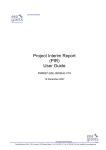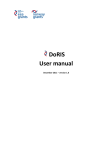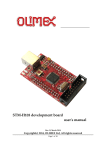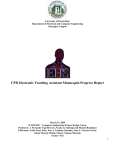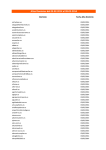Download Project Completion Report (PCR) User Guide
Transcript
Project Completion Report (PCR) User Guide FM0027-GDL-00041-EV11 14 December 2007 Financial Mechanism Office, 12-16 Rue Joseph II, 1000 Brussels, Belgium . Tel: +32 (0)2 286 1701 . Fax: +32 (0)2 286 1789 . Email: [email protected] . www.eeagrants.org Page 2 of 8 FM0027-GDL-0041-E-V1 1. Introduction The Project Completion Report (PCR) is a structured reporting format provided by the Financial Mechanism Office (FMO) and completed by the Project Promoter and the Focal Point. Regardless the type of project assistance (i.e. individual project, programme, or block grant), the same PCR format is to be used. In addition, there will always be one valid PCR per project even if the project is financed by both the EEA and Norwegian Financial Mechanism. According to the Financial Mechanisms’ legal framework, the PCR forms an integral part of the project planning and reporting structure, as the following diagram shows. Application Form (APF) Grant Agreement & Project Impl. Plan (PIP) Project Interim Report (PIR) = Payment claim Project Completion Report (PCR) Figure 1: project planning and reporting structure The completed PCR is divided into two parts; one part is prepared by the Project Promoter and the other by the Focal Point. The PCR provides the basis for evaluating the achievements of a project in terms of its overall objective, purpose and results. A submitted PCR will be compared against the Project Implementation Plan (PIP) and the Project Interim Reports. The PCR will serve as the basis for the disbursement of the Grant retention amount as defined in the Grant Agreement. The FMO will generate a tailor-made PCR template and send it electronically to the Project Promoter through the Focal Point within 10 working days after the processing of the last PIR. The Project Promoter shall fill in the PCR and return it electronically along with a signed hard copy to the Focal Point. The Focal Point certifies the PCR and forwards both the electronic and hard copy versions to the Paying authority. The Paying Authority certifies the commitment of the cash co-financing from the last PIR before it submits a request for disbursement of the Grant retention amount to the FMO. Fully certified and signed PCRs must be attached to the request for disbursement (a cover letter) and sent by post to the FMO. An identical electronic version of the PCRs must be sent to a dedicated e-mail address provided by the FMO to the Paying Authority. Note that the Paying Authority will not normally forward any additional supporting documentation to the FMO. For further details regarding disbursements, reporting and monitoring please refer to the Disbursement guidelines and Reporting and monitoring guidelines made available on the web site, www.eeagrants.org. This user guide describes in detail how to complete the PCR and specifies the information required in particular fields. Financial Mechanism Office, 12-16 Rue Joseph II, 1000 Brussels, Belgium . Tel: +32 (0)2 286 1701 . Fax: +32 (0)2 286 1789 . Email: [email protected] . www.eeagrants.org Page 3 of 8 FM0027-GDL-0041-E-V1 2. General form usage points to complete the PCR The following points need to be considered when completing the PCR: - The PCR is a Microsoft Excel Workbook. It is compatible with versions of this software from Excel 97 onwards, although the use of versions more recent that Excel 2000 is strongly recommended; - The PCR contains no Excel macros; - Editable cells are light blue in colour; all other cells are locked and not editable by the user; - Do NOT use cut/paste to move data from one part of the form, as this disrupts the form’s structure; - Do NOT drag entire cells by selecting the periphery for the same reason; - To copy the data from another sheet / another place in the same sheet: o copy the data from the source sheet (ctrl – C) o select the destination cells, and use ‘Paste Special’ with the ‘Values’ checkbox selected to paste data: Extending data from one cell to another by dragging the bottom right hand corner of the border is acceptable. Financial Mechanism Office, 12-16 Rue Joseph II, 1000 Brussels, Belgium . Tel: +32 (0)2 286 1701 . Fax: +32 (0)2 286 1789 . Email: [email protected] . www.eeagrants.org Page 4 of 8 FM0027-GDL-0041-E-V1 3. Detailed description of PCR fields This section describes the data in the PCR. This data comes from three sources: o o o entered by the Project Promoter gathered by the FMO from the Application Form, Project Implementation Plan (PIP) and Project Interim Report(s) calculated to provide information to the Project Promoter 3.0 Project Promoter This section of the PCR is provided for reference, and requires no input from the Project Promoter. If any of the details in this section are incorrect, then the Project Promoter should inform the Focal Point without delay. [0.1] Full Legal Name Populated with the information supplied in the Application Form associated with this PCR [0.2] Contact Person The name of the primary contact for the project. Whilst the vast majority of correspondence between the Project Promoter and the FMO will be via the Focal Point, any direct communication from the FMO to the Project Promoter will be addressed to this person. [0.3] Job Title The job title of the person named in [0.2] [0.4] Organisation The name of the organisation to which the person named in [0.2] belongs. In many cases this will be a department within the Project Promoter’s organisation named in [0.1], but may be a separate entity if the contact person is not part of that organisation. [0.5] Address The correspondence address for the person named in [0.2]. [0.6] Telephone The fixed line telephone number for the person named in [0.2]. [0.7] Mobile The mobile telephone number for the person named in [0.2]. [0.8] Fax The fax number for the person named in [0.2]. [0.9] Email The email address of the person named in [0.2]. 3.1. PART I – Project Summary This section of the PCR summarises the implementation of the project as a whole, from Project actual start date till the actual completion date. [1.1] Project Title The project title as defined in the Application Form. Financial Mechanism Office, 12-16 Rue Joseph II, 1000 Brussels, Belgium . Tel: +32 (0)2 286 1701 . Fax: +32 (0)2 286 1789 . Email: [email protected] . www.eeagrants.org Page 5 of 8 [1.2] FM0027-GDL-0041-E-V1 Project Number The project number assigned by the FMO on registration of the Application Form. All correspondence relating to this project should make reference to this number. [1.3] Total Grant Rate Awarded The ratio of grant awarded by the Financial Mechanism Committee (FMC) and/or Norwegian Ministry of Foreign Affairs (NMFA) to the eligible cost of the project, as defined in the Grant Agreement (PIP field [1.14]) [1.4] Total Grant Awarded (Euro) The total grant awarded under one or both mechanisms, as defined in the Grant Agreement (PIP field [1.12]) [1.5] Total Amount retained for PCR Approval The amount retained by the FMC to be disbursed after the approval of the certified PCR (PIR field [2.19] – ‘Total to date’). [1.6] Actual Total Project Cost From last PIR The total eligible expenses to date (PIR field [2.15] - ‘Total to date’) [1.7] Project Start Date The month in which work actually started on the project. [1.8] Project Planned Start Date The month in which the project was planned to start (PIP field [1.6]). [1.9] Project Completion Date The month in which the last PIR was submitted to the FMO. [1.10] Project Planned Completion Date The month in which the project was planned to finish (PIP field [1.7]). 3.2. PART II – Cash Co-financing This section is completed by the paying authority. In this section the Paying Authority certifies that the cash co-financing to be committed in the last PIR (PIR field [3.6] and [3.7]) has been committed to the project. [2.1] Start Date of Reporting Period Refers to the start date of the last reporting period (last PIR). [2.2] End Date of Reporting Period Refers to the end date of the last reporting period (last PIR). [2.3] Government Budget Sourcing from [3.6] in the last PIR. [2.4] Non-Public Sourcing from [3.7] in the last PIR. Signature The Paying Authority must certify that the co-financing has been committed as defined in the last PIR. Financial Mechanism Office, 12-16 Rue Joseph II, 1000 Brussels, Belgium . Tel: +32 (0)2 286 1701 . Fax: +32 (0)2 286 1789 . Email: [email protected] . www.eeagrants.org Page 6 of 8 FM0027-GDL-0041-E-V1 3.3. PART III – Financial Progress This section of the PCR summarises the financial completion of the project in euros per budged heading and compares it against its plan as stated in the Project Implementation Plan (PIP). Both the ‘Cash Eligible Expenses’ and ‘Revenue’ tables are structured in the similar way (see the description in the ‘Cash Eligible Expenses’ table below). The Revenue table will appear only for ‘revenue generating’ projects. The Cash Eligible Expenses – Budget Headings table shows the actual status of project expenditures with respect to the plan: Planned Financial Progress (expressed in the EUR value and percentage) Actual Financial Progress (expressed in the EUR value and percentage) The ‘Planned Financial Progress’ column summarises the plan of the financial project progress as represented in the current Project Implementation Plan. ‘Actual Financial Progress’ summarises the cash eligible expenses across all project expense categories (budget headings) in euros for the entire duration of the project up to the point of project completion. The column ‘Total’ is completed by the Project Promoter using the exchange rate provided by FMO and described in the PART XI of this Guideline. As non-eligible expenses are by definition not funded by the Financial Mechanisms, they are not considered in this table. Cash Eligible Expenses [3.1] Cash Eligible Expenses – Budget Headings The expense categories are predefined from the current PIP. However, there may have been changes made compared to the current PIP, thus the Project Promoter can introduce new expense categories at this stage, both up to four pre-defined expense categories (drop-down menu) and/or up to four userdefined categories. [3.2] Total Cash Eligible Expenses The total eligible expenditure over the project implementation period summed over all expense categories. Revenue [3.3] Standard Profit Margin The standard profit margin as it appears in the PIP. The Revenue table shows the actual status of project revenues and operating expenses with respect to the plan: - Planned (as represented in the PIP) - Actual (expressed in the EUR using exchange rate provided by the FMO) Revenue Sum of all revenues for the corresponding calendar year up to the point of project completion, completed by the Project Promoter, see the Revenue generating projects guideline. Operating Expense Sum of all operating expenses for the corresponding calendar year up to the point of project completion, completed by the Project Promoter, see the Revenue generating projects guideline. Brief description of the financial progress versus plan A description of the financial progress and results with a comparison to the foreseen progress and results. Financial Mechanism Office, 12-16 Rue Joseph II, 1000 Brussels, Belgium . Tel: +32 (0)2 286 1701 . Fax: +32 (0)2 286 1789 . Email: [email protected] . www.eeagrants.org Page 7 of 8 FM0027-GDL-0041-E-V1 3.4. PART IV – Project Indicators This section is completed by the Project Promoter and outlines overall achievement with respect to the planned Project Indicators as defined in Annex II of the Grant Agreement (PIP), and the actual Project Outcome. The “Project Outcome” column, of the tables [4.3], [4.7] and [4.11], requires a quantitative report of achieved results at Project Completion as compared to the pre-populated ‘Baseline’ column; tables [4.2], [4.6] and [4.10] and the ‘Target’ column; tables [4.4], [4.8] and [4.12]. Additional Comments This field requires that the Project Promoter makes a value statement and comment on the projects actual accomplishment when compared to the original plan. The outline shall highlight the overall achievement of the project indicators. Any deviation from the target values (Fields [4.4], [4.8] and [4.12]) should be described and explained. 3.5. PART V – Cross Cutting Issues The Project Promoter shall take into consideration the contribution of the project to the cross-cutting issues when evaluating the projects actual accomplishment. The attached table should advise the Project Promoter to comment only on the project relevant cross cutting issues, crossed in the last two columns, which are: - Important part of the project and - Fundamental to the project 3.6. PART VI – General conditions and post completion obligations In this section the Project Promoter should outline how conditions set out in article 6 of the Grant Agreement have been met and report, if relevant, on measures taken to ensure fulfilment of any post completion obligations as set out in article 7 of the Grant Agreement. 3.7. PART VII – Lessons learned and recommendations In this field the Project Promoter shall highlight and mediate any relevant lessons learned during project implementation and recommend on any follow-up actions that might be needed. 3.8. PART VIII –Project Promoter Signature This section of the PCR is only provided for signature by the Project Promoter which signs off and certifies that the report has been filled out correctly and in good faith. 3.9. PART IX – Summary statement by the Focal Point This field requires the Focal Point to summarise the project in its whole with respect to management and the overall project implementation. 3.10. PART X –Focal Point Signature This section of the PCR is only provided for signature by the Focal Point which signs off confirms that the information provided is accurate. Financial Mechanism Office, 12-16 Rue Joseph II, 1000 Brussels, Belgium . Tel: +32 (0)2 286 1701 . Fax: +32 (0)2 286 1789 . Email: [email protected] . www.eeagrants.org Page 8 of 8 FM0027-GDL-0041-E-V1 3.11. PART XI – Exchange Rate The Exchange Rate table will appear only for projects which do not report in EUR. The Project Promoter fills in the PCR using euros; however when converting expenses incurred in local currency to euros, the Project Promoter has to apply the exchange rate on a monthly basis covering the whole project life up to the point of project completion. For assistance these exchange rates are provided in this section. It is important to note that the same monthly exchange rates are used in the PIRs, in order to ensure comparability of the reports. Financial Mechanism Office, 12-16 Rue Joseph II, 1000 Brussels, Belgium . Tel: +32 (0)2 286 1701 . Fax: +32 (0)2 286 1789 . Email: [email protected] . www.eeagrants.org








